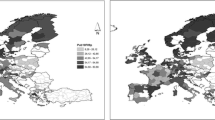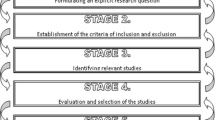Abstract
Does devoting more academic research resources promote academic quality? This study aims to examine the influence of higher education R&D expenditure (HERD) on academic quality measured by the relative citation impact (RCI). Both the ordered Probit and panel data models are employed to implement the empirical estimation, the cross-country evidence suggests that an increase in academic R&D is positively related to academic quality. The further analyses on different academic disciplines show the HERD is more relevant to science publications. This finding is robust for various specifications.

Similar content being viewed by others

Notes
The inter-disciplinary research is more complicated that the project involves academic researchers from different unrelated disciplines as well as non-academic participants.
Bornmann and Mutz (2011) suggest that a field-normalization index of citation ratio is a more adequate measure.
The indicators of Academic Ranking of World Universities (ARWU) and Leiden Ranking can be aggregated to the country level to measure research quality (Docampo 2011; Waltman et al. 2012). However, both rankings were available since 2003 and 2007 respectively, preventing us to use these alternatively methodologies.
We can further discuss the standards in various fields or disciplines through this indicator, formulated as \( RCI_{ij} = \left( {C_{ij} /P_{ij} } \right)/\left( {\sum\nolimits_{i = 1}^{N} {C_{ij} /\sum\nolimits_{i = 1}^{N} {P_{ij} } } } \right) \), where C ij stands for the RCI of discipline j in the ith country, and P ij for the number of papers in the jth discipline in the ith country.
Adopting a longer period to construct the stock measure results in similar estimation results.
The 34 OECD members contain: Australia, Austria, Belgium, Canada, Chile, Czech Republic, Denmark, Estonia, Finland, France, Germany, Greece, Hungary, Iceland, Ireland, Israel, Italy, Japan, Korea, Luxembourg, Mexico, Netherlands, New Zealand, Norway, Poland, Portugal, Slovak Republic, Slovenia, Spain, Sweden, Switzerland, Turkey, United Kingdom, and United States.
Despite journal articles are mostly written by researchers of higher education institutes, some of them are submitted from the government and industries. It means that the dependent variable of academic performance is overestimated, leading to an upward bias on the effect of HERD.
We use the random effects long-term tracking model for more convenient comparison with the order Probit model which considers the regional dummy variable.
For example, the funding of looking for excellent research our university got from the government is NT$500,000,000 per year. The funding distributed to social science (College of Literature and College of Management) is about NT$5,000,000, accounting for only 1 %.
References
Aguillo, I. F., Ortega, J. L., & Fernández, M. (2008). Webometric ranking of world universities: Introduction, methodology, and future developments. Higher Education in Europe, 33(2–3), 233–244.
Albarrán, P., Crespo, J. A., Ortuño, I., & Ruiz-Castillo, J. (2010). A comparison of the scientific performance of the US and the European Union at the turn of the 21st century. Scientometrics, 85(1), 329–344.
Auranena, O., & Nieminenb, M. (2010) Technology and innovation studies (TaSTI), institute for social research. Finland Research Policy, 39(4), 822–834.
Balassa, B. (1965). The liberalization and revealed comparative advantage. The Manchester School, 33, 99–123.
Bornmann, L., & Mutz, R. (2011). Further steps towards an ideal method of measuring citation performance: The avoidance of citation (ratio) averages in field-normalization. Journal of Informetrics, 5(1), 228–230.
Chan, K. C., Chen, C. R., & Cheng, T. W. (2005). Ranking research productivity in accounting for Asia-Pacific Universities. Review of Quantitative Finance and Accounting, 24(1), 47–64.
Chen, J. P., Hu, J. L., & Yang, C. H. (2013). Produce patents or journal articles? A cross-country comparison R&D productivity change. Scientometrics, 94(3), 833–849.
Cincera, M. (1997). Patents, R&D, and technological spillovers at the firm level: Some evidence from econometric count models for panel data. Journal of Applied Econometrics, 12(3), 265–280.
Crespi, G. A., & Geuna, A. (2008). An empirical study of scientific production: A cross country analysis, 1981–2002. Research Policy, 37, 565–579.
Cuneo, P., & Mairesse J. (1984). Productivity and R&D at the firm level in French manufacturing, R&D, patents, and productivity, NBER Conference Report. Chicago and London: University of Chicago Press, pp. 375-392.
De Moya-anegon, F., & Herrero-Solana, V. (1999). Science in America Latina: A comparison of bibliometric and scientific–technical indicators. Scientometrics, 46, 299–320.
Dill, D. D., & Soo, M. (2005). Academic quality, league tables, and public policy: A cross-national analysis of university ranking systems. Higher Education, 49(4), 495–533.
Docampo, D. (2011). On using the Shanghai ranking to assess the research performance of university systems. Scientometrics, 86(1), 77–92.
Garfield, E. (1996). The significant scientific literature appears in a small core of journals. Scientist, 10, 13–15.
Geuna, A., & Martin, B. R. (2003). University research evaluation and funding: An international comparison. Minerva, 41(4), 277–304.
Hall, B. H., & Mairesse, J. (1995). Exploring the relationship between R&D and productivity in France manufacturing firms. Journal of Econometrics, 65, 263–293.
Huang, W. C., Lee, L. C., & Tsai, M. H. (2009). An international comparison of relative contributions to academic productivity. Scientometrics, 81(3), 701–718.
Jacobs, D., & Ingwersen, P. (2000). A bibliometric study of the publication patterns in the sciences of South African scholars 1981–96. Scientometrics, 47(1), 75–93.
Kealey, T. (1996). The economic laws of scientific research. New York: St. Martin’s Press.
King, D. A. (2004). The scientific impact of nations: What different countries get for their research spending. Nature, 430, 311–316.
Kirman, A., & Dahl, M. (1994). Economic research in Europe. European Economic Review, 38(3–4), 505–522.
Kivinen, O., Hedman, J., & Kaipainen, P. (2013). Productivity analysis of research in natural sciences, technology and clinical medicine: An input–output model applied in comparison of top 300 ranked universities of 4 North European and 4 East Asian countries. Scientometrics, 94(2), 683–699.
Kocher, M. G., Luptacik, M., & Sutter, M. (2006). Measuring productivity of research in economics: A cross-country study using DEA. Socio-Economic Planning Sciences, 40(4), 314–332.
Kocher, M. G., & Sutter, M. (2001). The institutional concentration of authors in top journals of economics during the last two decades. Economic Journal, 111(5), F405–F421.
Kumari, G. L. (2009). Synthetic organic chemistry research: Analysis by scientometric indicators. Scientometrics, 80(3), 559–570.
Lehvo, A., & Nuutinen, A. (2006). Finnish science in international comparison—A bibliometric analysis. Helsinki: Academy of Finland.
Lewison, J. G. G., & May, R. M. (1997). Government funding of research and development. Science, 278, 878–880.
Liu, N. C., & Cheng, Y. (2005). The academic ranking of world universities. Higher Education in Europe, 30(2), 127–136.
Marginson, S. (2007). Global university rankings: Implications in general and for Australia. Journal of Higher Education Policy and Management, 29(2), 131–142.
May, R. M. (1997). The scientific wealth of nations. Science, 275, 793–796.
Osuna, C., Cruz-Castro, L., & Sanz-Menéndez, L. (2011). Overturning some assumptions about the effects of evaluation systems on publication performance. Scientometrics, 86(3), 575–592.
Patsopoulos, N. A., Analatos, A., & Ioannidis, J. P. (2005). Relative citation impact of various study designs in the health sciences. Journal of American Medical Association, 293(19), 2362–2366.
Vinkler, P. (1992). Research Policy and Publication Productivity. In Representations of science and technology: Proceedings of the International Conference on Science and Technology Indicators, Bielefeld (pp. 75–91). Leiden: DSWO Press, Leiden University.
Vinkler, P. (2008). Correlation between the structure of scientific research, scientometric indicators and GDP in EU and non-EU countries. Scientometrics, 74, 237–254.
Waltman, L., Calero-Medina, C., Kosten, J., & Noyons, E. (2012). The Leiden ranking 2011/2012: Data collection, indicators, and interpretation. Journal of the American Society for Information Science and Technology, 63(12), 2419–2432.
Wang, E. C., & Huang, W. C. (2007). Relative efficiency of R&D activities: A cross-country study accounting for environmental factors in the DEA approach. Research Policy, 36, 260–273.
Weingart, P. (2005). Impact of bibliometrics upon the science system: Inadvertent consequences? Scientometrics, 62(1), 117–131.
Author information
Authors and Affiliations
Corresponding author
Rights and permissions
About this article
Cite this article
Lin, PH., Chen, JR. & Yang, CH. Academic research resources and academic quality: a cross-country analysis. Scientometrics 101, 109–123 (2014). https://doi.org/10.1007/s11192-014-1362-z
Received:
Published:
Issue Date:
DOI: https://doi.org/10.1007/s11192-014-1362-z



